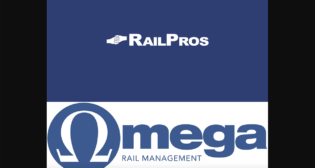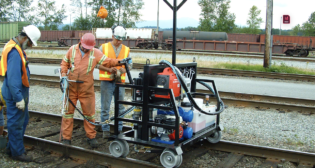
A tad off the top
Written by Douglas John BowenRail grinding service providers offer profile correction, modification, and restoration.
Rail grinding is a bit more scientific than just a metal removal means. Service providers are producing machines that are flexible and precise to fit the situational variety and intricacy required of North American railroads.
Harsco Rail
Harsco Rail designs and builds its rail grinding equipment to be flexible. “Flexibility is beneficial so that railways may use the same machine through the progression of a long term grinding program—maintaining consistency and reliability,” the company says. “Grinding programs develop for various reasons. Some customers begin grinding programs because they need profile correction or modification, with the intention of progressing to a maintenance program. Therefore, the machines need to be aggressive as it relates to horsepower and metal removal, but then after a few grinding cycles, the machine needs the ability to adjust patterns on the fly and accurately remove only the desired amount of metal at a specific area on the rail.
“Excessive grinding reduces rail life and it’s very important to only remove the metal you need to remove. As a grinding program enters the maintenance mode, the machine needs a control system that has the ability to remove a slight amount of metal to maintain the desired profile while producing an acceptable surface finish. Harsco Rail is active in the global heavy haul and transit markets and we have noticed that different regions around the world are at different stages,
as it relates to grinding methods and expectations. Some regions are just starting grinding programs as a way to reduce defects and derailments, while other regions have mature grinding programs and are extending rail life through gradual preventative and maintenance grinding practices.”
To ensure the proper program is being executed, Harsco Rail now offers a computer based Rail Grinding Overview training course that lasts approximately two hours and covers the history, application, and purpose of grinding. Upon finishing the course, an individual has the opportunity be granted a Certificate of Completion. Harsco Rail says it values the importance of education within the industry and understanding fundamentals are the most important aspect to that education.
Harsco Rail adds it is consistently exploring avenues to increase the efficiency of its services, equipment, and technology. “Our Intelligent Solutions group is currently partnering with railroads to develop the most effective and efficient rail grinding programs,” the company says. Through our Accelerometer Based Corrugation Measurement System and analysis of our industry consultants, we are able to deliver specialized rail grinding program recommendations to railroads. Furthermore, we are incorporating our new technology, SmartGrind, to dynamically and automatically develop new patterns during grinding. These patterns are based on active feedback from the previous pass in grinding operations. Finally, in the back-end of our grinding advances, we are exploring customized grinding-stone development to deliver high efficiency grinding.”
Loram
Marketing Specialist John Simmons says grinding and grinding services are the foundation of Loram Maintenance of Way, Inc. The company offers a complete line of grinders to tackle the variety and complexity of jobs presented by the rail industry. Simmons notes that Loram also has a complete line of services to complement its fleet of machines, beginning with a staff of skilled machine operators, maintenance crews, and support staff assuring the machine is ready for work when called and able to produce quality results.
Loram’s fleet of grinders includes the RG400 Series Grinder (RG401 pictured, opposite page), which can grind at up 20 mph, allows for deeper cutting angle capabilities to address all rail conditions, boasts auto machine lubrication to reduce maintenance and enhance accuracy, houses a state-of-the-art rail measurement and vision system to verify quality, and offers a robust dust collection system to lessen the impact on the environment. The company’s RGS Specialty Grinder can grind at speeds up to 12 mph, has the ability to reduce power to grinding motors as needed to vary surface finish, and has a fuel-efficient, low-emission EPA Tier II compliant engine.
Loram’s third offering is the L-Series Specialty Grinder, which can be rapidly transported at highway speeds to reach any work site, combines the technology from Loram’s heavy-haul main line grinders with a design to navigate transit systems, performs within most flangeway or field side clearance obstructions, is gauge-convertible, and comes with an integrated dust collection system and special noise-suppression system. The L-Series also utilizes Loram’s patented offset grinding that the company says allows the flexibility to grind a variety of rail conditions in tunnels or open rail spots.
“The railroads are moving more product today than ever before,” says Simmons. “The future looks bright for continued growth. However, the down side is reduced time for maintenance of the rails. Loram is constantly looking for innovative ways of getting more quality work done safely in less time.”
In addition to its grinders, Loram offers an asset management service to help railroads plan and execute grinding schedules utilizing the Loram Rail Inspection Vehicle (RIV). This vehicle is equipped with a track profile measurement and reporting package to track quality assurance and planning needs.
“This package is a proven system in use in North America and Australia and consists of several integrated components including state-of-the art optical transverse profile measurement systems, proprietary position locator system based on differential global positioning system (DGPS), proprietary profile analysis, grind quality control software, and proprietary data viewing and reporting software,” says Simmons. “The RIV ensures the most efficient application of the rail grinder to the rail conditions.”
Simmons says that with the increasing levels and sophistication of technology on the grinders, it is very important to have access to highly qualified technicians to assist the machine operators in problem resolution. This is why the company made enhancements to its Remote Machine Diagnostic System.
“Loram has the ability for a grinder to communicate real-time data with technicians at any time,” says Simmons. “This saves valuable time by allowing a technician to receive live data from the machine without having to be on it. Since technicians are able to gather pertinent data via the Internet, they can work with the operator in finding and resolving a problem much quicker. This is another way of maximizing production within the shrinking available time for grinding.”
Orgo-Thermit
Orgo-Thermit Inc. offers the VM8000, a 12-stone grinding vehicle equipped with four-wheel steering. The company says the machine is capable of road driving, which allows for quick on- and off-track movements, as well as the ability to drive to the grinding site without occupying track time.
Another feature Orgo-Thermit points out is the machine’s ability to skew its wheels to “slide” out of the way of an oncoming train and return to its original position. The company says it upgraded the unit’s dust collection system, which means there is minimal dust in open track and almost non-existent dust in embedded track, an accomplishment that has won Orgo-Thermit praise, especially for work in crowded areas.
“We can easily grind directly through crossings and get very close in switches,” says Director Field Services Randy Dry. “With our experienced team, mounting time is kept to within 25 seconds. This allows the stoppage of traffic, pedestrians, and trains to be kept to a minimum. No longer is it needed to wait for the last train to get into the yard, before departure. While other rail-bound machines are dead-heading out to a site from their tie-up location, the VM8000 has already been grinding since the last train passed the work site. Orgo-Thermit has been told by various transits that this ability sometimes allows for 1.5 hours more of spark time.”
In anticipation of acquiring a new machine, Orgo-Thermit says it has been keeping up with the latest technology, such as real-time profile monitoring and increased horsepower
to the grinding heads. “Everyone always wants more power,” says Dry. “The challenge is to figure how to get the power and keep the finish. He also says noise is always a major issue for transits in residential areas and notes the VM8000 is very quiet. “A normal conversation can be had while only 10 feet from the machine,” he notes. “Also in line with keeping things quiet is the finish. We’ve done much research to get an even finer finish. The VM8000 leaves behind very tight facets (with no ridges) and a scratch mark of only 3-6 microns. We’ve developed specialized grinding stones for different situations. Mill scale removal has always been the hardest to complete and keep passes to a minimum. With this new stone, the passes have been cut in half for mill scale removal. This helps to keep up with transit agency needs for increased production on shorter track times. Orgo-Thermit has also developed a Fine Finish stone. This stone leaves behind an immaculate finish, creating an absolute silent environment, when a train passes. There is no longer the need to wait one or two weeks for the train to wear in.”
Vossloh Rail Services
Vossloh Rail Services says it is committed to bring the technology of rail milling to the North American market in 2015 and notes the technology being offered will allow railroads and transits to experience just how clean a milled rail is.
The company says the technology does not produce sparks or heating of the rail, which means it can be used in potentially difficult areas, such as bridges and tunnels.
“With the use of eddy current technology, the validation of a truly clean rail, with no RCF (rolling contact fatigue), can be done immediately after the milling process is completed,” says Vice President and General Manager Ron Martin. “This process has proven to increase rail life and minimize rail renewal programs due to defects.”
As it pertains to tight work windows and the speed of grinding service, Martin says that question is really one of corrective vs. preventive maintenance. “Corrective grinding requires the removal of much more metal than does preventive maintenance grinding, so speed is dictated by metal removal rate,” he points out. “Conventional grinding, being powered stone grinding, also has the limitation of the amount of metal able to be removed based on the rotational rate of the stone and the pressure of that stone applied without negatively affecting the metallurgy of the rail.
“High Speed Grinding (HSG) is not a powered stone system but is based on the friction relation of the rail to the stone. This allows the system to work at much higher speeds, typically 50 mph, than is achieved by powered stone grinding. The HSG system was developed to allow a railroad to maintain the rail to as close to the desired optimal profile as possible by making frequent, but very fast, passes to minimize traffic disruption. The metal removal rate is minimal but will take out the RCF and correct rail flow or degradation before it can grow to the point of where corrective grinding is required. The technology has proven to increase rail life and decrease rail renewal programs requirements.”



